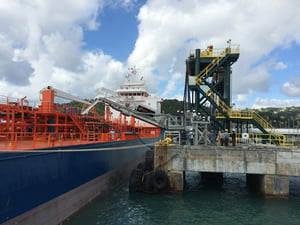Creating better marine safety conditions for a waterfront facility where workers load and unload ships and barges presents a unique set of challenges.
conditions for a waterfront facility where workers load and unload ships and barges presents a unique set of challenges.
The last thing you want is for one of your employees to have an accident that leads to serious injury or death. Not only would this devastate you and your workers, but it could expose your employer to serious financial risks such as OSHA compliance fines, workers’ compensation expenses and even possible litigation.
But, finding efficient, cost-effective methods to increase workplace safety for your facility is not always easy when you also need to keep day-to-day marine access operations running smoothly.
So, what steps should you take to make sure your employees work in the safest conditions possible? Here are three tips to help you improve marine safety at your facility.
Tip 1: Invest In The Right Equipment
People have been getting on and off ships for centuries, but the equipment that was used hundreds of years ago does not provide your employees enough protection in today’s safety climate.
To prevent accidents and injuries, you need to be sure that your marine facility has the highest quality safety equipment. Proper safety equipment reduces the risks of slips, trips and falls. Marine ladders and marine gangways offer increased fall prevention and protection over rope ladders and Jacob’s ladders. As we noted in our last post, opting for passive safety solutions helps create conditions that prevent workers from falling and injuring themselves.
Finding safety equipment solutions that work with a wide variety of ships and barges also helps lessen the dangers of accidents and injuries. If you find a safety solution that only works for one type of ship, it might fall short when unloading another type of ship, increasing the chance that your workers find themselves unprotected.
If you’re unsure about the right equipment and safety system to install for your marine facility, working with a safety expert helps you establish your needs and goals.
Tip 2: Mandate Proper Safety Training
Investing in the best quality marine access safety equipment is practically meaningless unless your employees follow proper safety protocols. You might have the most secure barge gangway on the market, but workers are still at serious risk of falling and injuring themselves if they’re jumping on and off the barge. After all, a barge is a moving target and the distance it takes to leap from dock to barge may shift while your worker is mid-air.
Make sure your workers undergo extensive safety procedure training and are well versed in the proper usage of all of your safety equipment. However, it’s not enough to just run your employees through a quick safety process training. You need to fully explain to the workers on your dock the risks involved with violating safety protocols so they are more inclined to follow your safety guidelines at all times, even when management isn’t watching.
You also need to establish proper safety training for new employees. In too many industries, accidents and injuries are blamed on “the new guy” not knowing proper procedure. Don’t let this happen at your marine facility.
Tip 3: Understand Your Safety Goals
Far too often, proper safety equipment and comprehensive safety procedures do not get installed and implemented due to poor interdepartmental communications. The Operations department realizes they need new access. Engineering is then tasked to find the safest solution. Accounting just wants to spend as little time and money as possible.
Increasing the communication between these departments helps them all understand the benefits of instilling a safety culture into their organization. It also helps everyone understand the serious financial risks that companies are exposed to by unsafe working conditions. When departments connect on marine safety projects at the outset, the right safety solutions at the right price are much easier to implement.
Safer marine access begins with identifying safety hazards like inadequate equipment as well as establishing proper training. Follow the three tips above to ensure greater workplace safety for your employees and avoid the risks of accidents and injuries.
Need to keep your workplace moving efficiently while meeting corporate and OSHA compliance? Click below to download this industry guide from Carbis Solutions to discover the secrets to a safer – and more efficient – work site.




